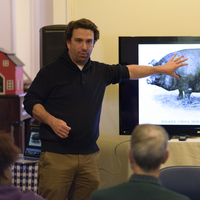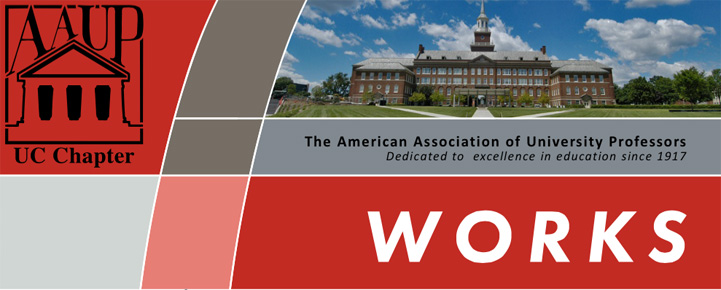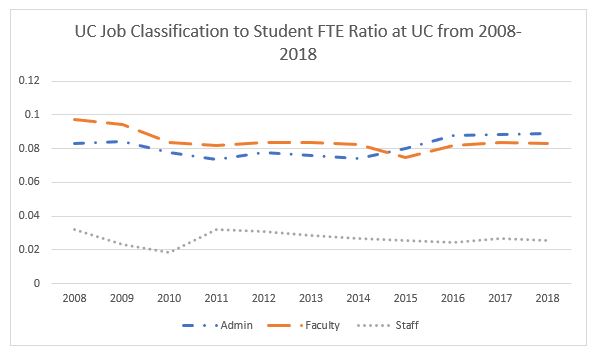In this issue:
UC Administrators Out Number Faculty
Durable Medical Equipment
FacultyFaculty Spotlight
UC Administrators Out Number Faculty
In past issues of The Works, the AAUP has tracked how the ratio of full-time faculty to student full time equivalencies (FTE) has fallen over the past decade despite record breaking enrollments and a 25% increase in student FTES. New research indicates that not only have the ratio of faculty* FTEs to student FTE’s decreased, but the ratio of staff** FTEs to student FTEs has fallen as well. The ratio of administrator*** FTEs to student FTEs, however, has risen during this same time frame. In 2008, the total number of staff FTEs was 970, but by 2018, that number fell to 967. In other words, UC had approximately 1 staff FTE per 31 student FTEs in 2008, but by 2018, UC had 1 staff FTE per 38 student FTEs. Although the total number of faculty FTEs rose during this decade from 2918 faculty FTEs to 3140 FTEs, the faculty FTE to student FTE ratio increased from 1 faculty FTE to 10.3 student FTES in 2008 to 1 faculty FTEs to 11.7 student FTES in 2018. UC saw a significant increase in the total number of administrators, which rose from 2505 FTEs in 2008 to 3361 FTEs in 2018. In 2008, UC had 1 administrator FTE for roughly 12 student FTEs, but the increase in 856 administrator FTE’s by 2018 dropped the ratio to 1 administrator FTE for roughly 11 student FTES. As you can see from the graph below, the ratio of administrators to students surpassed faculty to student ratios between 2014 and 2015.
If having more administrators to students than faculty to students wasn’t troubling enough, these numbers only tell part of the story. This data comes from the Integrated Post-Secondary Education Data System (IPEDS)****, which doesn’t distinguish between full-time and part-time faculty. In past issues of The Works, the AAUP has discussed the decreasing number of full time faculty members as well as the decrease in tenure track lines, but this data suggests that even with increasing reliance on contingent faculty we are falling behind in our faculty to student ratios.
In the 51% campaign, the AAUP has argued that 51% of college revenue should stay in the college and be controlled by the college, but currently, colleges only retain approximately 43% of their revenue. An additional 3% cut to college budgets has been announced for the upcoming fiscal year 2021. The increase of 856 administrator FTEs points to a potential explanation for where a portion of the colleges’ revenue has been diverted. Further research comparing the total salary dollars of each of these categories would help illuminate what the impact of these administrator FTEs have had on UC’s budget.
*For the purpose of this research, faculty are defined using the Higher Learning Commissions definition. HLC’s definition of faculty includes “employees whose primary responsibilities are instruction, research and/or public service.” This definition includes full and part time faculty including graduate assistants.
** For the purpose of this research, staff are defined using the Higher Learning Commissions definition. HLC’s definition of staff “includes the following IPEDs categories: Service Occupations; Sales and Related Occupations; Office and Administrative Support Occupations; Natural Resources, Constructions and Maintenance Occupations; Production, Transportation and Material Moving Operations.” Full and part-time employees are included in this definition.
*** For the purpose of this research, administrators are defined using the Higher Learning Commissions definition. HLC’s definition of administration “includes the following IPEDs categories: Management Operations; Business and Financial Operation Occupations; Librarians, Computer, Engineering and Science Occupations; Community, Social Service, Legal, Arts, Design, Entertainment, Sports and Media Occupations, Healthcare Practitioners and Technical Occupations; Archivists, Curators, Museum Technicians; Library Technicians; Student and Academic Affairs and other Educational Services Occupations.” Full and part-time employees are included in this definition.
****IPEDS is run by National Center for Educational Statistics, which is part of the Institute for Educational Sciences. The Institute for Educational Sciences serves as the non-partisan evaluation division of the U.S. Department of Education.
***** Acknowledgement – In the fall, the Ohio University AAUP (OU-AAUP) chapter released the “Ohio University Budget Crisis: Analysis and Proposals” white paper, which inspired this research.
Durable Medical Equipment
During a caucus for bargaining last spring, the bargaining team realized that in some cases the Anthem PPO plan was covering in network Durable Medical Equipment (DME)* at 80% instead of 90% as required by the Collective Bargaining Agreement (CBA). The AAUP filed a formal grievance on behalf of all bargaining unit members in June. Human Resources directed Anthem to correct the rate and re-run the Explanation of Benefits (EOB’s) for DME’s in 2016-2019. In total, the incorrect coverage impacted 439 bargaining unit members** or their dependents and included 1313 claims. The adjusted claims amounted to $18,926.58 that was due to the bargaining unit members, and the majority of the claims were for CPAPs. All affected bargaining unit members should have received updated EOB’s if they had DME’s billed at 80%. The corrected EOB’s were completed by August 9, 2019. Refunds for overpayment, however, are to be paid to the patient by the provider. If you have not received reimbursement, please contact your provider.

This grievance highlights an advantage of being represented by a union. Without the AAUP, each of the 439 members of the bargaining unit would have to 1) realize that they were over billed and 2) work on their own to correct the issue with Anthem (likely a time-consuming process). The grievance process allowed the AAUP to file a class action grievance and members, some of whom may have had no idea that an error in billing had occurred, are now entitled to a refund. WE ARE STRONGER WORKING TOGETHER! *The 2019 Anthem Medical Benefit Booklet defines DME’s as “Equipment which is (a) made to withstand prolonged use; (b) made for and mainly used in the treatment of a disease of Injury; (c) suited for use while not confined as an Inpatient at a Hospital; (d) not normally of use to persons who do not have a disease or Injury; (e) not for exercise or training.” Examples of DME’s include CPAP machines, insulin pumps, wheelchairs, custom made knee braces, etc. **The total affected bargaining unit members may not be unique. Some members could have been impacted in more than one year.
 Questions and Answers with:Robert Gioielli Associate Professor of History, UCBA Director, UCBA Honors
Questions and Answers with:Robert Gioielli Associate Professor of History, UCBA Director, UCBA Honors
1. What do you do here at UC and what’s one thing you really love about it?
I love that UC is a so grounded and connected to our local community. Although we can always do a better job with connections and engagement, having the majority of our students be from the Cincinnati area means that our teaching, training and research has a direct impact on the future of our community. I also love the fact we are an urban institution, embedded right in the city, with all of the challenges and opportunities that provides.
2. What’s something about your work you wish people knew more about?
Much of my work, both research but also teaching, has been about diversifying who gets to speak about environmental issues, and whose environmental issues we pay attention to. Traditionally the environment was primarily considered to be a priority among people like myself: white, well-educated, middle-class. But environmental issues affect us all, and often marginalized communities feel the brunt of it, as Hurricane Katrina, the Flint Water Crisis, and rapid climate change are showing us now. My research has been focused on show the deep and complex history of activism by people of color, as well as the ways that racism shapes sustainability issues within our cities. I also have worked to diversify our environmental studies curriculum, developing a new course, “Race and Environment in American History,” that will be taught at UC Blue Ash in Spring 2020, and on a regular basis thereafter.
3. What are your hopes for your students in the future?
I hope that we as faculty can work with our students to demand a more holistic and robust education for all. Unfortunately I see us going back to a nineteenth-century model, where humanistic studies, and education for the development of people and communities, for the development of good citizens, is solely reserved for an elite. In the 1800s it was wealthy, white men; today its students who have the resources and connections to attend prestigious private colleges. We are going rapidly going down the road of telling students that public universities are primarily for vocational training. That is a dangerous and self-destructive path, not only for our students, but also society. We need to collectively demand that every American, not just the wealthy and the lucky, deserve a holistic, well-rounded education.
What profession other than your own would you like to attempt?
I was a reporter at a small town newspaper for three years before getting my PhD. I still miss daily newspaper journalism, even though I know the business is not what it was twenty years ago.
What is your motto?
“Life is either a daring adventure, or nothing at all.” Helen Keller

